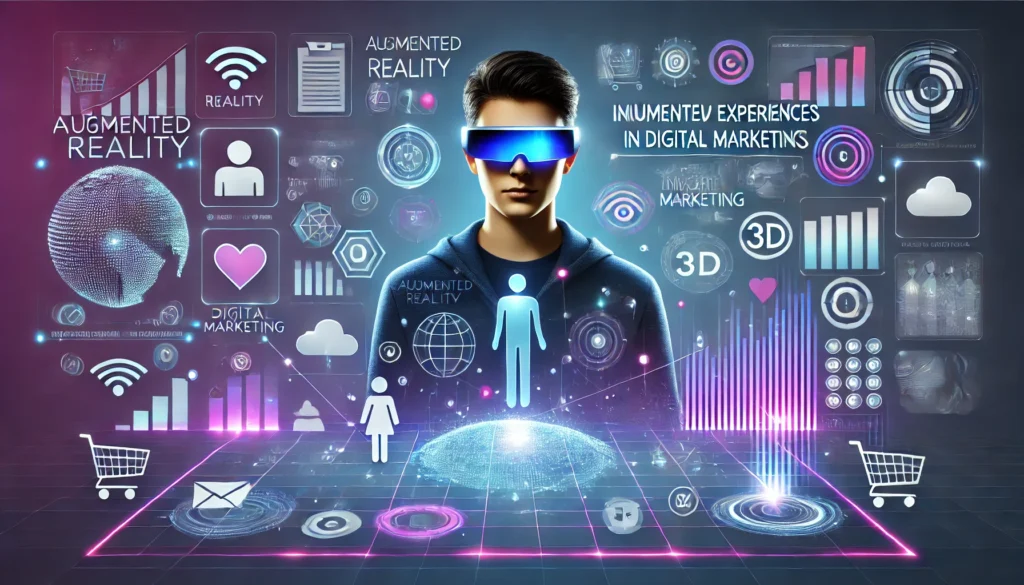Augmented Reality Immersive Experiences in Digital Marketing
The digital marketing landscape is evolving rapidly, and one of the most exciting innovations reshaping the industry is Augmented Reality (AR). By blending digital elements with the real world, AR creates interactive and immersive experiences that engage consumers like never before. As brands compete for attention in an increasingly crowded marketplace, AR offers a unique way to capture interest, enhance user experience, and drive conversions.
What Is Augmented Reality in Marketing?
Augmented Reality (AR) enhances the physical world by overlaying digital content, such as images, sounds, or 3D models, onto a real-world environment. Unlike Virtual Reality (VR), which creates an entirely digital experience, AR enhances real-life surroundings through a smartphone, tablet, or AR glasses.
In marketing, AR transforms how brands interact with customers. Instead of passively consuming content, users actively engage with it, leading to deeper brand connections and increased retention rates. From virtual try-ons to interactive packaging, AR is revolutionizing the customer journey.
Why Augmented Reality Is a Game-Changer in Digital Marketing
- Enhances Customer Engagement
AR content is interactive and visually appealing, making it more engaging than traditional digital ads or static content. - Bridges the Gap Between Online and Offline Shopping
AR allows consumers to visualize products in real-life settings, reducing uncertainty and increasing confidence in online purchases. - Provides a Memorable Brand Experience
People remember interactive experiences better than traditional ads. AR helps brands stand out by offering fun and innovative ways to interact with products and services. - Increases Conversion Rates
By giving customers a hands-on feel for products, AR helps drive purchasing decisions. Many brands have reported increased sales after incorporating AR features into their marketing strategies. - Encourages Social Sharing
Users are more likely to share AR experiences on social media, providing organic brand exposure and increasing reach.
How Brands Can Use AR in Marketing
1. Virtual Try-Ons
One of the most popular uses of AR is virtual try-on technology. Beauty brands like Sephora and L’Oréal allow customers to test makeup shades using AR apps, while fashion retailers like Warby Parker let shoppers try on glasses virtually before purchasing.
2. AR Shopping Experiences
IKEA’s AR-powered IKEA Place app enables users to visualize how furniture would look in their homes before buying, reducing the likelihood of returns and enhancing customer satisfaction.
3. Interactive Advertising
AR ads are more engaging than static or video ads. Companies like Pepsi have used AR billboards to create interactive street marketing campaigns that grab attention and go viral.
4. Gamification and Brand Engagement
Brands use AR to create interactive games that encourage customer participation. For example, Pokémon GO’s AR-based scavenger hunt demonstrated the potential for brands to engage audiences in new and exciting ways.
5. Enhanced Product Packaging
AR-enabled packaging brings products to life. Customers can scan a QR code on a package to unlock exclusive content, tutorials, or immersive brand storytelling.
6. Live Events and Experiences
Brands can enhance in-store experiences and live events using AR. Nike, for example, has used AR in its stores to provide customers with exclusive content and interactive experiences that deepen brand engagement.
Companies Leading the Way in AR Marketing
Several brands have successfully integrated AR into their marketing strategies:
- Snapchat & Instagram: Social media platforms have pioneered AR filters that allow users to engage with brands in a fun and interactive way.
- Nike: Their AR-powered sneaker try-ons and interactive in-store experiences create a seamless digital-physical shopping journey.
- Google & Apple: ARCore and ARKit provide businesses with the tools to develop innovative AR applications.
- L’Oréal & Sephora: Beauty brands leverage AR for virtual makeup try-ons, making it easier for customers to choose the right products.
- IKEA & Wayfair: These retailers use AR to help customers visualize furniture in their homes, enhancing online shopping experiences.
The Future of AR in Marketing
As AR technology advances, its role in digital marketing will only expand. The rise of AR glasses, AI-powered AR interactions, and 5G connectivity will make immersive brand experiences even more seamless. Future applications may include:
- AI-Driven AR Personalization: Custom AR experiences tailored to individual preferences and behaviors.
- AR-Powered E-Commerce: More brands will integrate AR into their websites, allowing users to try before they buy.
- Augmented Reality in Social Commerce: AR shopping on social platforms like Instagram and TikTok will become more mainstream.
Conclusion
Augmented Reality is transforming digital marketing by creating immersive, interactive, and memorable brand experiences. From virtual try-ons to interactive advertising and gamified content, AR offers endless possibilities for brands to engage consumers in meaningful ways. As technology continues to evolve, businesses that embrace AR will stand out in a competitive market, driving deeper connections and greater customer loyalty.
The future of marketing is immersive, and AR is leading the way. Brands that invest in AR today will shape the digital experiences of tomorrow, setting new standards for customer engagement and innovation.

